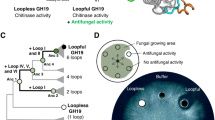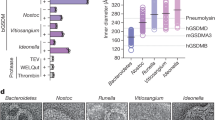Abstract
The iron ion is an essential cofactor in several vital enzymatic reactions, such as DNA replication, oxygen transport, and respiratory and photosynthetic electron transfer chains, but its excess accumulation induces oxidative stress in cells. Vacuolar iron transporter 1 (VIT1) is important for iron homeostasis in plants, by transporting cytoplasmic ferrous ions into vacuoles. Modification of the VIT1 gene leads to increased iron content in crops, which could be used for the treatment of human iron deficiency diseases. Furthermore, a VIT1 from the malaria-causing parasite Plasmodium is considered as a potential drug target for malaria. Here we report the crystal structure of VIT1 from rose gum Eucalyptus grandis, which probably functions as a H+-dependent antiporter for Fe2+ and other transition metal ions. VIT1 adopts a novel protein fold forming a dimer of five membrane-spanning domains, with an ion-translocating pathway constituted by the conserved methionine and carboxylate residues at the dimer interface. The second transmembrane helix protrudes from the lipid membrane by about 40 Å and connects to a three-helical bundle, triangular cytoplasmic domain, which binds to the substrate metal ions and stabilizes their soluble form, thus playing an essential role in their transport. These mechanistic insights will provide useful information for the further design of genetically modified crops and the development of anti-malaria drugs.
This is a preview of subscription content, access via your institution
Access options
Access Nature and 54 other Nature Portfolio journals
Get Nature+, our best-value online-access subscription
$29.99 / 30 days
cancel any time
Subscribe to this journal
Receive 12 digital issues and online access to articles
$119.00 per year
only $9.92 per issue
Buy this article
- Purchase on Springer Link
- Instant access to full article PDF
Prices may be subject to local taxes which are calculated during checkout






Similar content being viewed by others
Data availability
Data supporting the findings of this manuscript are available from the corresponding authors upon reasonable request. Coordinates and structure factors have been deposited in the Protein Data Bank, with the accession codes PDB 6IU3 and 6IU4 for non-soaked and Co2+-soaked EgVIT123-249, and 6IU5, 6IU6, 6IU8, and 6IU9 for Zn2+-bound, Ni2+-soaked, Co2+-soaked, and Fe2+-soaked EgVIT170-144, respectively. X-ray diffraction images are also available at Zenodo data repository (https://zenodo.org/record/2532136 for full length with Co/Zn; https://zenodo.org/record/2532134 for MBD; https://zenodo.org/record/2532138 for SIR datasets).
References
Zhang, C. Essential functions of iron-requiring proteins in DNA replication, repair and cell cycle control. Protein Cell 5, 750–760 (2014).
White, M. F. & Dillingham, M. S. Iron-sulphur clusters in nucleic acid processing enzymes. Curr. Opin. Struct. Biol. 22, 94–100 (2012).
Rouault, T. A. Mammalian iron-sulphur proteins: novel insights into biogenesis and function. Nat. Rev. Mol. Cell Biol. 16, 45–55 (2015).
Beinert, Holm. & Münck, E. Iron-sulfur clusters: nature’s modular, multipurpose structures. Science 277, 653 (1997).
Balk, J. & Schaedler, T. A. Iron cofactor assembly in plants. Annu. Rev. Plant Biol. 65, 125–153 (2014).
Aust, S. D., Morehouse, L. A. & Thomas, C. E. Role of metals in oxygen radical reactions. J. Free Radic. Biol. Med. 1, 3–25 (1985).
Andrews, N. C. & Schmidt, P. J. Iron homeostasis. Annu. Rev. Physiol. 69, 69–85 (2007).
Bogdan, A. R., Miyazawa, M., Hashimoto, K. & Tsuji, Y. Regulators of iron homeostasis: new players in metabolism, cell death, and disease. Trends Biochem. Sci. 41, 274–286 (2016).
Morrissey, J. & Guerinot, M. Lou Iron uptake and transport in plants: the good, the bad, and the ionome. Chem. Rev. 109, 4553–4567 (2009).
Jain, A., Wilson, G. T. & Connolly, E. L. The diverse roles of FRO family metalloreductases in iron and copper homeostasis. Front. Plant Sci. 5, 100 (2014).
Hider, R. C. & Kong, X. Chemistry and biology of siderophores. Nat. Prod. Rep. 27, 637 (2010).
Guerinot, M. Lou & Yi, Y. Iron: nutritious, noxious, and not readily available. Plant Physiol. 104, 815–820 (1994).
Sharma, S. S., . & Dietz, K. & Mimura, T. Vacuolar compartmentalization as indispensable component of heavy metal detoxification in plants. Plant Cell Environ. 39, 1112–1126 (2016).
Li, L., Chen, O. S., Ward, D. M. & Kaplan, J. CCC1 is a transporter that mediates vacuolar iron storage in yeast. J. Biol. Chem. 276, 29515–29519 (2001).
Kim, S. A. et al. Localization of iron in Arabidopsis seed requires the vacuolar membrane transporter VIT1. Science 314, 1295–1298 (2006).
Zhang, Y., Xu, Y., Yi, H. & Gong, J. Vacuolar membrane transporters OsVIT1 and OsVIT2 modulate iron translocation between flag leaves and seeds in rice. Plant J. 72, 400–410 (2012).
Narayanan, N. et al. Overexpression of Arabidopsis VIT1 increases accumulation of iron in cassava roots and stems. Plant Sci. 240, 170–181 (2015).
Connorton, J. M. et al. Wheat vacuolar iron transporter TaVIT2 transports Fe and Mn and is effective for biofortification. Plant Physiol. 174, 2434–2444 (2017).
De Steur, H. et al. Status and market potential of transgenic biofortified crops. Nat. Biotechnol. 33, 25–29 (2015).
Slavic, K. et al. A vacuolar iron-transporter homologue acts as a detoxifier in Plasmodium. Nat. Commun. 7, 10403 (2016).
Weiner, J. & Kooij, T. Phylogenetic profiles of all membrane transport proteins of the malaria parasite highlight new drug targets. Microb. Cell 3, 511–521 (2016).
Ehrnstorfer, I. A., Geertsma, E. R., Pardon, E., Steyaert, J. & Dutzler, R. Crystal structure of a SLC11 (NRAMP) transporter reveals the basis for transition-metal ion transport. Nat. Struct. Mol. Biol. 21, 990–996 (2014).
Taniguchi, R. et al. Outward- and inward-facing structures of a putative bacterial transition-metal transporter with homology to ferroportin. Nat. Commun. 6, 8545 (2015).
Parker, J. L., Mindell, J. A. & Newstead, S. Thermodynamic evidence for a dual transport mechanism in a POT peptide transporter. eLife 3, 1–13 (2014).
Nieboer, E. & Richardson, D. H. S. The replacement of the nondescript term ‘heavy metals’ by a biologically and chemically significant classification of metal ions. Environ. Pollut. Ser. B, Chem. Phys. 1, 3–26 (1980).
Ehrnstorfer, I. A., Manatschal, C., Arnold, F. M., Laederach, J. & Dutzler, R. Structural and mechanistic basis of proton-coupled metal ion transport in the SLC11/NRAMP family. Nat. Commun. 8, 14033 (2017).
Curie, C. et al. Metal movement within the plant: contribution of nicotianamine and yellow stripe 1-like transporters. Ann. Bot. 103, 1–11 (2009).
Álvarez-Fernández, A., Díaz-Benito, P., Abadía, A., López-Millán, A. F. & Abadía, J. Metal species involved in long distance metal transport in plants. Front. Plant Sci. 5, 105 (2014).
Gollhofer, J., Timofeev, R., Lan, P., Schmidt, W. & Buckhout, T. J. Vacuolar-iron-transporter1-like proteins mediate iron homeostasis in Arabidopsis. PLoS ONE 9, 1–8 (2014).
Bhubhanil, S. et al. Roles of Agrobacterium tumefaciens membrane-bound ferritin (MbfA) in iron transport and resistance to iron under acidic conditions. Microbiology 160, 863–871 (2014).
Forrest, L. R., Krämer, R. & Ziegler, C. The structural basis of secondary active transport mechanisms. Biochim. Biophys. Acta Bioenerg. 1807, 167–188 (2011).
Shi, Y. Common folds and transport mechanisms of secondary active transporters. Annu. Rev. Biophys. 42, 51–72 (2013).
Saoudi, N., Latcu, D. G., Rinaldi, J. P. & Ricard, P. Graphical analysis of pH-dependent properties of proteins predicted using PROPKA. Bull. Acad. Natl Med. 192, 1029–1041 (2011).
Bozzi, A. T. et al. Conserved methionine dictates substrate preference in Nramp-family divalent metal transporters. Proc. Natl Acad. Sci. USA 113, 10310–10315 (2016).
Shen, J. et al. Organelle pH in the arabidopsis endomembrane system. Mol. Plant 6, 1419–1437 (2013).
Brachmann, C. B. et al. Designer deletion strains derived from Saccharomyces cerevisiae S288C: a useful set of strains and plasmids for PCR-mediated gene disruption and other applications. Yeast 14, 115–132 (1998).
Caffrey, M. Crystallizing membrane proteins for structure determination: use of lipidic mesophases. Annu. Rev. Biophys. 38, 29–51 (2009).
Kabsch, W. XDS. Acta Crystallogr. Sect. D Biol. Crystallogr. 66, 125–132 (2010).
Yamashita, K., Hirata, K. & Yamamoto, M. KAMO: towards automated data processing for microcrystals. Acta Crystallogr. Sect. D Struct. Biol. 74, 441–449 (2018).
Foadi, J. et al. Clustering procedures for the optimal selection of data sets from multiple crystals in macromolecular crystallography. Acta Crystallogr. Sect. D Biol. Crystallogr. 69, 1617–1632 (2013).
Schneider, T. R. & Sheldrick, G. M. Substructure solution with SHELXD. Acta Crystallogr. Sect. D Biol. Crystallogr. 58, 1772–1779 (2002).
De La Fortelle, E. & Bricogne, G. Maximum-likelihood heavy-atom parameter refinement for multiple isomorphous replacement and multiwavelength anomalous diffraction methods. Methods Enzymol. 276, 472–494 (1997).
Adams, P. D. et al. PHENIX: building new software for automated crystallographic structure determination. Acta Crystallogr. Sect. D Biol. Crystallogr. 58, 1948–1954 (2002).
Emsley, P., Lohkamp, B., Scott, W. G. & Cowtan, K. Features and development of Coot. Acta Crystallogr. Sect. D Biol. Crystallogr. 66, 486–501 (2010).
Sheldrick, G. M. A short history of SHELX. Acta Crystallogr. Sect. A Found. Crystallogr. 64, 112–122 (2008).
Thorn, A. & Sheldrick, G. M. ANODE: anomalous and heavy-atom density calculation. J. Appl. Crystallogr. 44, 1285–1287 (2011).
Murshudov, G. N. et al. REFMAC5 for the refinement of macromolecular crystal structures. Acta Crystallogr. Sect. D Biol. Crystallogr. 67, 355–367 (2011).
Zwart, P. H., Grosse-Kunstleve, R. W. & Adams, P. D. Xtriage and Fest: automatic assessment of X-ray data and substructure structure factor estimation. CCP4 Newsletter 43, 27–35 (2005); http://www.ccp4.ac.uk/newsletters/newsletter43/articles/PHZ_RWGK_PDA.pdf.
Kawate, T. & Gouaux, E. Fluorescence-detection size-exclusion chromatography for precrystallization screening of integral membrane proteins. Structure 14, 673–681 (2006).
Acknowledgements
We thank all of the members of the Nureki laboratory, especially H. Nishimasu, H. Hirano, S. Hirano, and W. Shihoya for data collection at SLS and SPring-8; A. Kurabayashi and M. Miyazaki for technical assistance in the research; and the beamline staff members at PXI X06SA of the Swiss Light Source (Villigen, Switzerland), 05A of the Taiwan Photon Source (Hsinchu, Taiwan) and BL32XU of SPring-8 (Hyogo, Japan). The diffraction experiments were performed at the Swiss Light Source and at SPring-8 BL32XU and BL41XU (proposals 2015A1024, 2015A1057, 2015B2024, 2015B2057, and 2016A2527), with the approval of RIKEN. This work was supported by a MEXT Grant-in-Aid for Specially Promoted Research (grant 16H06294) to O.N. This work was also supported by JSPS KAKENHI (grant 17J06203 to T.K.; 15H06862 to K.Y.; 17H05000 to T. Nishizawa; 16H06574 to R.I.). H.K. and T. Nishizawa. were funded by JST, PRESTO (grants JPMJPR14L9 and JPMJPR14L8, respectively).
Author information
Authors and Affiliations
Contributions
T.K. purified and crystallized EgVIT1, determined the structure, planned the mutational analyses, and performed the liposome assays, under the supervision of K.K., R.T., R.I., T. Nishizawa, and O.N. K.Y. and K.H. assisted with the diffraction data collection and the data analyses. M.W. performed the yeast spot analysis and western blotting, under the supervision of K.I. T. Nakane and T. Nishizawa assisted with the data analyses. R.I., T.K., T. Nishizawa, and O.N. wrote the manuscript, with feedback from all of the authors. T. Nishizawa and O.N. supervised the research.
Corresponding authors
Ethics declarations
Competing interests
The authors declare no competing interests.
Additional information
Journal peer review information Nature Plants thanks Rachelle Gaudet, Simon Newstead and other anonymous reviewers for their contribution to the peer review of this work
Publisher’s note: Springer Nature remains neutral with regard to jurisdictional claims in published maps and institutional affiliations.
Supplementary information
Supplementary Information
Supplementary Figures 1–10, and Supplementary Tables 1 and 2.
Rights and permissions
About this article
Cite this article
Kato, T., Kumazaki, K., Wada, M. et al. Crystal structure of plant vacuolar iron transporter VIT1. Nat. Plants 5, 308–315 (2019). https://doi.org/10.1038/s41477-019-0367-2
Received:
Accepted:
Published:
Issue Date:
DOI: https://doi.org/10.1038/s41477-019-0367-2
This article is cited by
-
Dynamic Expressions of Yellow Stripe-Like (YSL) Genes During Pod Development Shed Light on Associations with Iron Distribution in Phaseolus vulgaris
Biochemical Genetics (2024)
-
The vacuolar iron transporter mediates iron detoxification in Toxoplasma gondii
Nature Communications (2023)
-
Mycorrhizal symbiosis alleviates Mn toxicity and downregulates Mn transporter genes in Eucalyptus tereticornis under contrasting soil phosphorus
Plant and Soil (2023)
-
Significance and genetic control of membrane transporters to improve phytoremediation and biofortification processes
Molecular Biology Reports (2023)
-
Texture feature extraction from microscope images enables a robust estimation of ER body phenotype in Arabidopsis
Plant Methods (2021)



